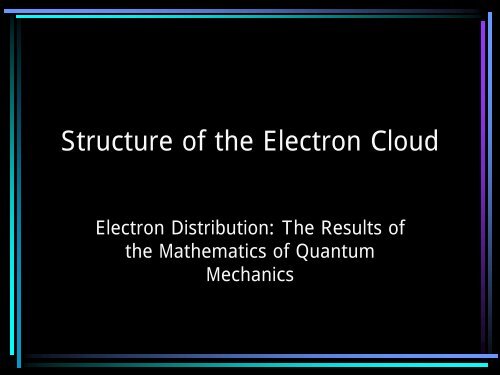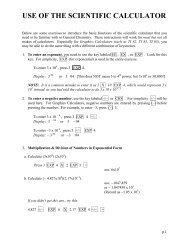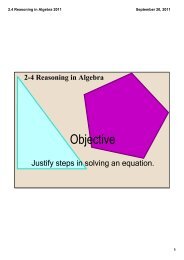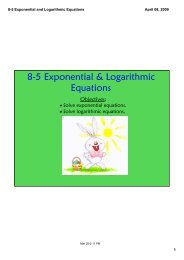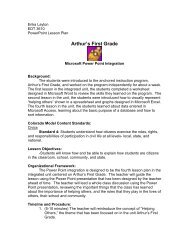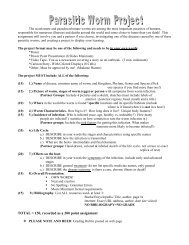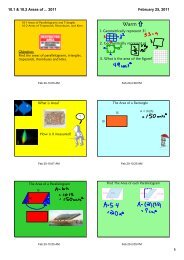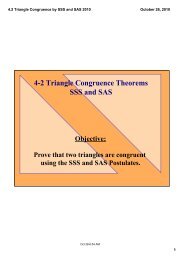You also want an ePaper? Increase the reach of your titles
YUMPU automatically turns print PDFs into web optimized ePapers that Google loves.
<strong>Structure</strong> of the <strong>Electron</strong> <strong>Cloud</strong><br />
<strong>Electron</strong> Distribution: The Results of<br />
the Mathematics of Quantum<br />
Mechanics
Levels of Organization<br />
• The term, ‘electron cloud’ doesn’t tell us<br />
very much about electron location.<br />
• This cloud is actually highly structured.<br />
• It is divided into:<br />
– Principal energy levels (PELs or shells )<br />
• Energy sublevels (or subshells)<br />
–Orbitals
PEL Review<br />
• Atoms may have from 1-7 PELs that are<br />
concentric spheres.<br />
• Level 1 is closest to the nucleus and<br />
level 7 found only with the largest<br />
atoms is the highest PEL.
Energy Sublevels<br />
• Principal energy levels are subdivided<br />
into 1-4 sublevels, depending on how<br />
large the PEL is.<br />
• Sublevels are designated as s, p, d and<br />
f.<br />
• Each sublevel has a different number of<br />
orbitals, and the orbitals have different<br />
shapes.
Orbitals<br />
• An orbital is the region of space where<br />
there is a 90% probability of finding an<br />
electron of a particular energy.<br />
• A single orbital may be home to 1 or 2<br />
electrons, but never more than 2.
The ‘s’ sublevel<br />
• The ‘s’ sublevel is the simplest.<br />
• It has only 1 orbital, which is a sphere.<br />
• The orbital can house 2 electrons.
Reality<br />
• Please keep in mind that<br />
orbitals are not solid<br />
shapes as the previous<br />
picture suggests. The<br />
sphere represents 90%<br />
electron density.<br />
• A real orbital would<br />
probably have a fuzzy<br />
appearance, more like<br />
this.
The ‘p’ sublevel<br />
• The ‘p’ sublevel is larger<br />
than the ‘s’ and consists<br />
of 3 orbitals which each<br />
look like this.<br />
• The p-orbital is bi-lobed<br />
and can also house 2<br />
electrons.<br />
• The grey circle in the<br />
center represents the s-<br />
orbital.
The ‘p’ sublevel<br />
z<br />
• The ‘p’ sublevel<br />
consists of 3 orbitals,<br />
each at right angles<br />
to each other in<br />
space.<br />
• Thus, the entire<br />
sublevel can hold up<br />
to 6 electrons total.<br />
y<br />
x
The ‘p’ sublevel<br />
z<br />
• The 3 orbitals of<br />
the p-sublevel are<br />
designated as p x ,<br />
p y and p z for the<br />
3 axes upon<br />
which they lie in<br />
space.<br />
y<br />
x
The ‘d’ sublevel<br />
• The ‘d’ sublevel consists of 5 orbitals<br />
whose shapes are more complex.<br />
• The sublevel can house 10 electrons.<br />
• The orbitals have 2 different types of<br />
shapes, and are oriented in space so as<br />
not to overlap each other.
d- orbitals<br />
• Four of the d-<br />
orbitals look like<br />
this.<br />
The fifth d-orbital<br />
looks like this.
‘d’ sublevel<br />
• Altogether, the d-<br />
orbitals occupy a<br />
common space,<br />
but do not<br />
overlap each<br />
other.<br />
• The whole<br />
sublevel looks like<br />
this.
‘f’ sublevel<br />
• The ‘f’ sublevel has 7 orbitals, home to 14<br />
electrons and is much more complex.<br />
• The orbitals look like this.
Heisenberg Uncertainty Principle<br />
• The whole idea that electrons occupy 3-<br />
dimensional volumes of space came<br />
from Werner Heisenberg who said that<br />
was impossible to know both the speed<br />
and location of tiny, fast-moving<br />
electrons at the same time.<br />
• This became know as the<br />
“Heisenberg Uncertainty Principle.”
Heisenberg Uncertainty Principle
Pauli Exclusion Principle<br />
• Another famous<br />
physicist, Wolfgang<br />
Pauli stated that a<br />
single atomic orbital,<br />
regardless of size or<br />
shape can only hold<br />
2 electrons, and<br />
those electrons must<br />
have opposite spin.
<strong>Electron</strong> Spin<br />
• Like charge, particles<br />
have another quality<br />
called ‘spin.’<br />
• There are only 2<br />
possible values,<br />
parallel (up) or antiparallel<br />
(down).
Putting It All Together<br />
• PEL 1 is small and ‘close’ to the nucleus.<br />
• It only has 1 sublevel, an ‘s’ and so has<br />
room for only 2 electrons.<br />
• When the 1 st PEL is filled with 2 e - , the<br />
next electrons must go into the 2 nd PEL.
Putting It All Together<br />
• The 2 nd PEL is larger, and so has room<br />
for more electrons.<br />
• It has an ‘s’ sublevel, and a ‘p’ sublevel.<br />
• The ‘s’ has room for 2 e - while the ‘p’<br />
sublevel with its 3 orbitals, has room for<br />
6 more, giving a total of 8 electrons in<br />
the 2 nd PEL.
Atomic Models<br />
• Perhaps now it is easy to see where<br />
those Bohr models of the atom are<br />
coming from. Easy to understand, but<br />
not accurate.
Putting It All Together<br />
• PEL 3 is larger still, and has room for a<br />
greater number of electrons.<br />
• It has s, p and d sublevels.<br />
• The ‘s’ sublevel can hold 2 e - , the ‘p’<br />
can hold 6, and the ‘d’ can hold 10 (5<br />
orbitals) for a total of 18.
Putting It All Together<br />
• PELs 4-7 all have s, p, d, and f possible<br />
sublevels.<br />
• s 2 e - (1 orbital)<br />
• p 6 e - (3 orbitals)<br />
• d 10 e - (5 orbitals)<br />
• f 14 e - (7 orbitals)<br />
• Total of 32 electrons.
A Helpful Table<br />
PEL<br />
1 2 3 4 5-7<br />
Sublevels<br />
s s / p s p d s p d f Same as<br />
4<br />
Orbitals<br />
In<br />
Sublevel<br />
e- in<br />
sublevel<br />
Total e- in<br />
PEL<br />
1 1 / 3 1/3/5 1/3/5/7 Same as<br />
4<br />
2 2 / 6 2/6/10 2/6/10/14 Same as<br />
4<br />
2 8 18 32 Same as<br />
4


